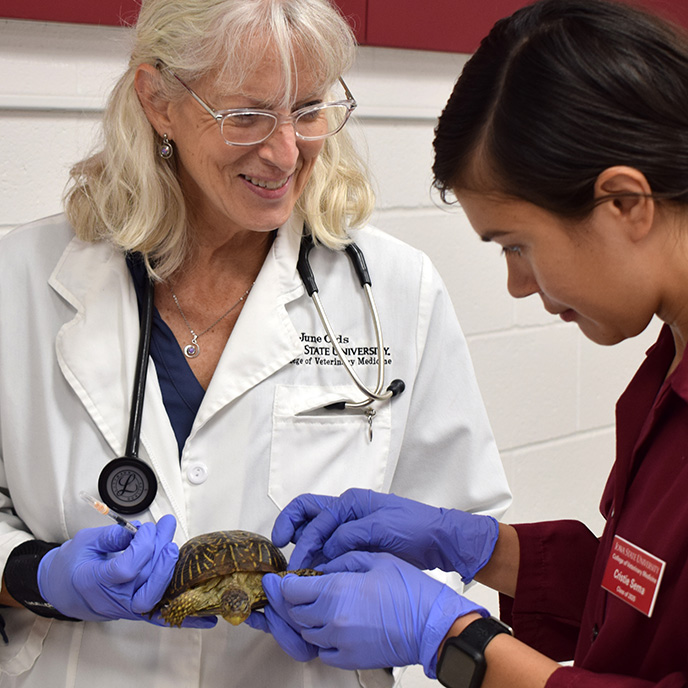 Dogs and cats make up a vast majority of the patients coming through the Hixson-Lied Small Animal Hospital.
Dogs and cats make up a vast majority of the patients coming through the Hixson-Lied Small Animal Hospital.
But for two clinical rotations held this summer, two dozen fourth-year students got to experience something out of the ordinary – rabbits, guinea pigs, chinchillas, hedgehogs, snakes, lizards and turtles.
The rotation was co-taught by Dr. June Olds, clinical associate professor of veterinary clinical sciences, and Dr. Jeffrey Applegate, board-certified veterinarian in exotic pet medicine and owner and Nautilus Avian and Exotics Veterinary Specialists in New Jersey. The pair were assisted by Des Moines-area veterinarians with experience in exotic pet medicine.
Over the two-week clinical rotations held twice this summer, students gained hands-on experience in physical exams, diagnosis, and treatment of common pet species. Each student had previously taken a pre-requisite course on exotic animals.
The rotation covered everything from proper restraint methods to safe venipuncture as well as surgical procedures.
“I would like to incorporate exotic animal medicine into my future veterinary practice,” said fourth-year student Kimberly Calderon. “I’ve always been fascinated by the diversity of species beyond small animals and livestock. This rotation offered an excellent opportunity to expand my knowledge and skills in this specialized area.”
For another fourth-year student, Megan Beckler, the opportunity to assist with an extensive work-up on a ball python was one she wasn’t expecting.
“Milky was diagnosed with a late-stage immature cataract in one eye,” Beckler said. “Exotic pet owners like Milky’s owner have a difficult time finding veterinary care. I was excited to serve these clients, not only in this rotation, but also in the future so exotic pets can have access to proper care.”
The students saw more rabbits than any other species during the rotation. Not only did they perform physical exams on rabbits, but the students did spay and neuters on rescue rabbits.
For some students, like Lauren Reilly, this was the first time they had done extensive work with rabbits.
“We saw quite a few rabbits in the rotation and by the end of the two weeks, I felt comfortable doing a physical exam and handling rabbits,” Reilly said. “I would now feel comfortable seeing a rabbit in general practice someday, where I did not feel that way before this rotation.”
Michelle Langlois agreed with her classmate.
“Prior to vet school, I had plenty of experience caring for wild cottontail and marsh rabbits, but I had never worked with domesticated rabbits,” Langlois said. “Domesticated rabbits are a very common household pet, and having hands-on experience caring for them pre- and post-operatively, as well as developing preventive care plans for them, were all experiences that’ll apply in any further encounters I have caring for different breeds of rabbits.”
Langlois, who is a member of the Zoo, Exotics, and Wildlife (ZEW) Medicine Club at Iowa State, took advantage of the rotation and brought her 17-year-old cornsnake, Arty, for his yearly exam.
“Seeing my classmates work with and learn from Arty brought me much joy,” Langlois said.
It was those “out of the ordinary” patients that fascinated the students.
“I loved the sheer variety of species we handled,” Calderon said. “One day we’d be treating a bearded dragon, the next an African grey parrot.
“The diversity kept things exciting and challenging.”
September 2024
